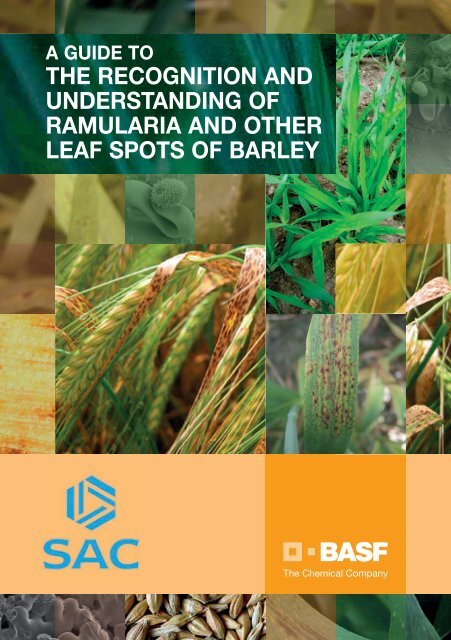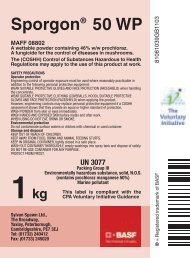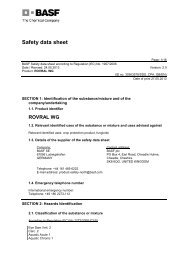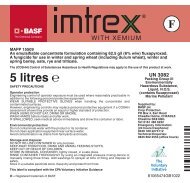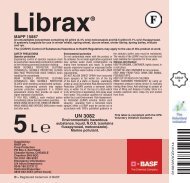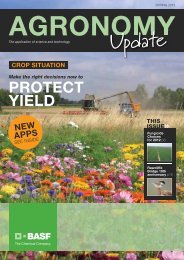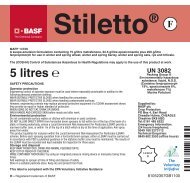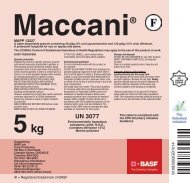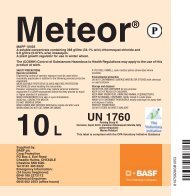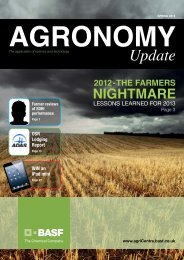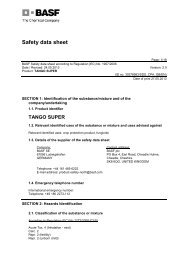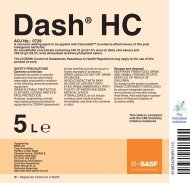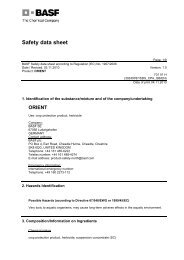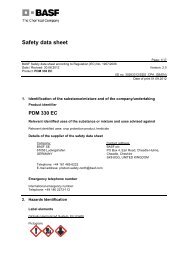a guide to the recognition and understanding of ramularia and other ...
a guide to the recognition and understanding of ramularia and other ...
a guide to the recognition and understanding of ramularia and other ...
Create successful ePaper yourself
Turn your PDF publications into a flip-book with our unique Google optimized e-Paper software.
A GUIDE TO<br />
THE RECOGNITION AND<br />
UNDERSTANDING OF<br />
RAMULARIA AND OTHER<br />
LEAF SPOTS OF BARLEY<br />
The Chemical Company
Introduction<br />
INTRODUCTION 1<br />
Ramularia, or more fully <strong>ramularia</strong> leaf spot, is <strong>the</strong> common name for <strong>the</strong><br />
barley disease caused by <strong>the</strong> fungus Ramularia collo-cygni.<br />
The disease was first recorded in 1893, but it is only in <strong>the</strong> last 15 years<br />
that it has become recognised as an economically important disease both<br />
in Europe, Argentina <strong>and</strong> New Zeal<strong>and</strong>. The disease is however more<br />
widespread <strong>and</strong> in some regions remains under reported, since <strong>ramularia</strong><br />
leaf spot symp<strong>to</strong>ms are easily mistaken for o<strong>the</strong>r more common diseases or<br />
misidentified as physiological leaf spots.<br />
In some areas it is has become one <strong>of</strong> <strong>the</strong> key diseases threatening barley<br />
<strong>and</strong> <strong>the</strong>refore should be a key consideration when planning fungicide<br />
programmes. Never<strong>the</strong>less, <strong>the</strong>re remains some confusion regarding its<br />
identification, particularly in areas where it currently occurs infrequently.<br />
The primary motivation for producing this <strong>guide</strong> is <strong>the</strong>refore <strong>to</strong> help with<br />
identification. The inclusion <strong>of</strong> pho<strong>to</strong>graphs <strong>of</strong> ‘spots’ produced by a range<br />
<strong>of</strong> o<strong>the</strong>r fac<strong>to</strong>rs will fur<strong>the</strong>r help <strong>to</strong> distinguish <strong>ramularia</strong> in <strong>the</strong> field.<br />
Information on <strong>the</strong> background biology <strong>of</strong> this important disease is also<br />
included, which will add interest, as well as an appreciation <strong>of</strong> how best <strong>to</strong><br />
approach its control.<br />
There is still more <strong>to</strong> learn about <strong>the</strong> epidemiology <strong>of</strong> <strong>ramularia</strong> leaf spot,<br />
but some advice is given on <strong>the</strong> current integrated control measures which<br />
can be taken <strong>to</strong> help limit <strong>the</strong> loss in yield <strong>and</strong> quality caused by <strong>ramularia</strong>,<br />
as well as physiological leaf spots.<br />
The production <strong>of</strong> this <strong>guide</strong> was a team effort bringing <strong>to</strong>ge<strong>the</strong>r <strong>the</strong><br />
authors Simon Oxley, Neil Havis <strong>and</strong> Andy Evans <strong>of</strong> SAC <strong>to</strong>ge<strong>the</strong>r with<br />
Steve Waterhouse <strong>and</strong> Lindy Tonguç <strong>of</strong> BASF who edited <strong>and</strong> formatted it.<br />
The publication was funded by BASF <strong>and</strong> SAC. We hope you find it<br />
interesting <strong>and</strong> informative.<br />
Authors<br />
Simon Oxley Neil Havis Andy Evans Steve Waterhouse Lindy Tonguç
2<br />
Contents<br />
RAMULARIA<br />
Distribution<br />
Current distribution ......................................................................4<br />
Symp<strong>to</strong>ms<br />
CONTENTS<br />
Future projection <strong>of</strong> risk in Europe ..............................................6<br />
Early stage ....................................................................................8<br />
Intermediate stage ........................................................................8<br />
Later stage ..................................................................................12<br />
Symp<strong>to</strong>ms on stems <strong>and</strong> awns ....................................................16<br />
Seed ............................................................................................19<br />
Symp<strong>to</strong>m appearance<br />
Tillering <strong>to</strong> flag leaf emergence....................................................20<br />
Post ear emergence ......................................................................20<br />
Life cycle<br />
Sources <strong>of</strong> infection ....................................................................22<br />
Asymp<strong>to</strong>matic (invisible) phase ..................................................22<br />
Symp<strong>to</strong>matic (visible) phase ........................................................23<br />
Spore dispersal ............................................................................24<br />
Secondary infection during <strong>the</strong> season ........................................25<br />
Secondary infection <strong>of</strong> leaves from airborne spores ....................25<br />
Asteromella production ..............................................................28<br />
Control measures<br />
Varietal resistance........................................................................31<br />
Seed health <strong>and</strong> seed treatments ..................................................31<br />
Foliar fungicides..........................................................................32<br />
- Timing ......................................................................................32<br />
- Choice ......................................................................................34<br />
- Resistance ................................................................................35
Contents<br />
PHYSIOLOGICAL LEAF SPOTS<br />
CONTENTS 3<br />
Symp<strong>to</strong>ms<br />
Effect <strong>of</strong> light stress ....................................................................36<br />
Effect <strong>of</strong> variety ..........................................................................36<br />
Interaction with <strong>ramularia</strong> leaf spot ......................................................41<br />
Physiological leaf spots <strong>and</strong> pollen scorch ..............................................43<br />
Physiological leaf spots in response <strong>to</strong> disease attack ............................44<br />
Control <strong>of</strong> physiological leaf spot<br />
Variety ........................................................................................46<br />
Nutrition ....................................................................................46<br />
Activity <strong>of</strong> fungicides ..................................................................49<br />
DISEASES CAUSING SIMILAR SYMPTOMS TO RAMULARIA LEAF SPOT<br />
Net blotch ..................................................................................50<br />
Pyrenophora leaf stripe ..............................................................52<br />
Halo spot ....................................................................................53<br />
Sep<strong>to</strong>ria nodorum ......................................................................54<br />
Glossary ................................................................................................55<br />
References <strong>and</strong> fur<strong>the</strong>r reading ..............................................................56<br />
Acknowledgements ................................................................................58
4<br />
RAMULARIA LEAF SPOT DISTRIBUTION<br />
Ramularia leaf spot distribution<br />
Ramularia leaf spot caused by <strong>the</strong><br />
fungus Ramularia collo-cygni is<br />
recognised as an economically<br />
important disease <strong>of</strong> barley in<br />
Europe, South America <strong>and</strong> New<br />
Zeal<strong>and</strong>. The fungus has been<br />
reported on o<strong>the</strong>r grass species <strong>and</strong><br />
also on maize <strong>and</strong> is likely <strong>to</strong> be more<br />
widely distributed in regions where<br />
barley is not grown or where<br />
<strong>ramularia</strong> leaf spot is not recognised<br />
<strong>to</strong> be a serious threat <strong>to</strong> barley.<br />
The disease has been reported<br />
throughout Europe <strong>and</strong> <strong>the</strong>se<br />
maps show <strong>the</strong> countries where<br />
<strong>ramularia</strong> leaf spot was first<br />
reported on barley in Europe <strong>and</strong><br />
throughout <strong>the</strong> world.<br />
First reported outbreaks <strong>of</strong> <strong>ramularia</strong> leaf spot in Europe<br />
Worldwide distribution <strong>of</strong> <strong>ramularia</strong> leaf spot <strong>and</strong> Ramularia collo-cygni
RAMULARIA LEAF SPOT DISTRIBUTION<br />
The potential distribution <strong>of</strong> <strong>the</strong> disease has been mapped using climate<br />
matching s<strong>of</strong>tware. These maps are based on <strong>the</strong> optimum wea<strong>the</strong>r<br />
conditions for Scotl<strong>and</strong>, where <strong>the</strong> disease is established as an important<br />
economic disease.<br />
It shows <strong>the</strong> potential for <strong>the</strong> disease <strong>to</strong> become established in most<br />
European countries including countries around <strong>the</strong> Black Sea where no<br />
<strong>of</strong>ficial outbreaks have been confirmed.<br />
Regions in Europe where wea<strong>the</strong>r conditions are suitable for <strong>ramularia</strong> leaf spot<br />
In <strong>the</strong> sou<strong>the</strong>rn hemisphere, New Zeal<strong>and</strong> is at risk from <strong>ramularia</strong> leaf<br />
spot <strong>and</strong> <strong>the</strong> disease is well established in that region. The disease has also<br />
been reported in <strong>the</strong> New South Wales region <strong>of</strong> Australia.<br />
Regions in Australia & New Zeal<strong>and</strong> where wea<strong>the</strong>r conditions are suitable for <strong>ramularia</strong> leaf spot<br />
5
6<br />
RAMULARIA LEAF SPOT DISTRIBUTION<br />
The world map based on <strong>the</strong> potential distribution <strong>of</strong> <strong>the</strong> disease shows <strong>the</strong><br />
greatest risk from <strong>ramularia</strong> leaf spot <strong>to</strong> be Europe, New Zeal<strong>and</strong>,<br />
Argentina <strong>and</strong> <strong>the</strong> east <strong>and</strong> west coast <strong>of</strong> Canada. This distribution links<br />
well with known outbreaks, but <strong>the</strong> disease is more widespread in North<br />
<strong>and</strong> South America suggesting <strong>the</strong> pathogen can adapt <strong>to</strong> different<br />
climates.<br />
Regions where wea<strong>the</strong>r conditions are suitable for <strong>ramularia</strong> leaf spot<br />
Since seed movement is an important method <strong>of</strong> spreading <strong>the</strong> fungus,<br />
<strong>the</strong>re is a real threat that <strong>ramularia</strong> leaf spot will become endemic in <strong>the</strong>se<br />
regions if barley is grown.<br />
If new populations <strong>of</strong> <strong>the</strong> fungus develop which enable <strong>the</strong> fungus <strong>to</strong> adapt<br />
<strong>to</strong> new environments, <strong>the</strong> regions where <strong>the</strong> disease could become<br />
economically important will increase fur<strong>the</strong>r.<br />
Future projection <strong>of</strong> risk in Europe from <strong>ramularia</strong> leaf spot<br />
Using a climate change forecast based on medium greenhouse gas<br />
emissions, <strong>the</strong> disease has <strong>the</strong> potential <strong>to</strong> remain a problem in <strong>the</strong> same<br />
countries in 2050, but <strong>the</strong> distribution within those countries can change.<br />
A greater threat will come from changes in <strong>the</strong> pathogen, which could lead<br />
<strong>to</strong> new races developing which can adapt <strong>to</strong> climate change or enable <strong>the</strong><br />
disease <strong>to</strong> spread <strong>to</strong> o<strong>the</strong>r barley growing regions.
Projected distribution <strong>of</strong> <strong>ramularia</strong> leaf spot in 2050<br />
RAMULARIA LEAF SPOT DISTRIBUTION 7
8<br />
Early stages<br />
SYMPTOMS<br />
What are <strong>the</strong> symp<strong>to</strong>ms <strong>of</strong> <strong>ramularia</strong> leaf<br />
spot on barley leaves?<br />
At <strong>the</strong> earliest stage <strong>of</strong> symp<strong>to</strong>m development, small brown irregular<br />
“pepper spots” appear on <strong>the</strong> leaf. These are just visible <strong>to</strong> <strong>the</strong> naked eye.<br />
At this very early stage, <strong>the</strong> symp<strong>to</strong>ms can be indistinguishable from<br />
physiological leaf spots caused by high light. However, <strong>ramularia</strong> leaf spots<br />
will be visible on both sides <strong>of</strong> <strong>the</strong> leaf, unlike physiological leaf spots<br />
which are more superficial <strong>and</strong> only visible on <strong>the</strong> side <strong>of</strong> <strong>the</strong> leaf exposed<br />
<strong>to</strong> <strong>the</strong> light.<br />
Intermediate stage<br />
The early “pepper spot“ symp<strong>to</strong>m <strong>of</strong> <strong>ramularia</strong> quickly develops in<strong>to</strong><br />
typical <strong>ramularia</strong> leaf spot lesions. Look for rectangular dark brown<br />
lesions typically 2 mm x 0.5 mm in size. They have straight longitudinal<br />
sides where <strong>the</strong> lesions are defined by <strong>the</strong> leaf ridges. The shorter sides <strong>of</strong><br />
<strong>the</strong> lesions are more irregular. At <strong>the</strong> centre <strong>of</strong> <strong>the</strong> brown lesions <strong>the</strong>re is<br />
<strong>the</strong> darker brown centre where <strong>the</strong> original “pepper spot” symp<strong>to</strong>m<br />
occurred. The whole brown rectangular lesion is surrounded by a yellow<br />
(or chlorotic) halo. This in turn is surrounded by a normal green leaf at<br />
this intermediate stage.<br />
Distinctive features <strong>of</strong> <strong>ramularia</strong> leaf spot lesions are that <strong>the</strong>y are easily<br />
seen both on <strong>the</strong> upper <strong>and</strong> lower surface <strong>of</strong> <strong>the</strong> leaf <strong>and</strong> <strong>the</strong> longitudinal<br />
edges <strong>of</strong> <strong>the</strong> brown lesion remain enclosed by <strong>the</strong> leaf ridges.
Pepper spot symp<strong>to</strong>m <strong>of</strong> <strong>ramularia</strong> leaf spot alongside distinctive rectangular symp<strong>to</strong>ms.<br />
Pepper spot symp<strong>to</strong>m <strong>of</strong> <strong>ramularia</strong> leaf spot alongside distinctive rectangular symp<strong>to</strong>ms.<br />
SYMPTOMS 9
10<br />
SYMPTOMS<br />
Pepper spot symp<strong>to</strong>m <strong>of</strong> <strong>ramularia</strong> leaf spot alongside distinctive rectangular symp<strong>to</strong>ms.<br />
Classic <strong>ramularia</strong> leaf spot symp<strong>to</strong>ms surrounded by pepper spot symp<strong>to</strong>ms
Classic <strong>ramularia</strong> leaf spot lesions on upper side on leaf<br />
Classic <strong>ramularia</strong> leaf spot symp<strong>to</strong>ms on underside <strong>of</strong> <strong>the</strong> same leaf<br />
SYMPTOMS 11
12<br />
Later stage<br />
SYMPTOMS<br />
The rectangular lesions remain visible on <strong>the</strong> upper <strong>and</strong> lower side <strong>of</strong><br />
<strong>the</strong> leaf but <strong>the</strong> leaf dies back rapidly losing all its green leaf initially<br />
turning yellow (chlorotic) before dying back completely. This die-back<br />
usually starts <strong>to</strong> occur at <strong>the</strong> leaf tip. On <strong>the</strong> underside <strong>of</strong> <strong>the</strong> dead leaf,<br />
translucent spores <strong>of</strong> Ramularia collo-cygni develop in lines coming<br />
out from <strong>the</strong> leaf pores (s<strong>to</strong>mata). These spores are not associated with<br />
<strong>the</strong> dark rectangular lesions which will still be visible on <strong>the</strong> dead<br />
leaves. The translucent spores can be seen using a magnifying h<strong>and</strong><br />
lens or occasionally by <strong>the</strong> naked eye. Wet conditions late in <strong>the</strong> season<br />
can lead <strong>to</strong> a red colouration around <strong>ramularia</strong> leaf spot lesions on<br />
dead leaves.<br />
Later stage <strong>of</strong> <strong>ramularia</strong> leaf spot
Later stage <strong>of</strong> <strong>ramularia</strong> leaf spot on <strong>the</strong> underside <strong>of</strong> <strong>the</strong> same leaf<br />
Later stage <strong>of</strong> <strong>ramularia</strong> leaf spot showing loss <strong>of</strong> green leaf area at leaf tip<br />
SYMPTOMS 13
14<br />
SYMPTOMS<br />
Extensive <strong>ramularia</strong> leaf spot symp<strong>to</strong>ms on leaf surrounded by dead leaf<br />
Extensive <strong>ramularia</strong> leaf spot symp<strong>to</strong>ms on leaf surrounded by dead leaf
Spores <strong>of</strong> Ramularia collo-cygni on <strong>the</strong> underside <strong>of</strong> a barley leaf<br />
Spores <strong>of</strong> Ramularia collo-cygni on <strong>the</strong> underside <strong>of</strong> a barley leaf (Scanning electron micrograph)<br />
SYMPTOMS 15
16<br />
SYMPTOMS<br />
Ramularia leaf spot symp<strong>to</strong>ms on stems <strong>and</strong> awns<br />
Ramularia leaf spot lesions also appear on <strong>the</strong> awns <strong>and</strong> leaf sheaths on<br />
barley stems. The dark brown rectangular lesions are small when<br />
compared <strong>to</strong> leaf symp<strong>to</strong>ms, but <strong>the</strong>y also comprise dark brown<br />
rectangular flecks surrounded by a yellow halo. The lesions continue <strong>to</strong><br />
remain visible after <strong>the</strong> awns <strong>and</strong> leaf sheaths have died-back.<br />
Ramularia leaf spot on flag leaf <strong>and</strong> leaf sheath
Early stage <strong>of</strong> <strong>ramularia</strong> leaf spot on flag leaf surrounded by green leaf<br />
Later stage <strong>of</strong> <strong>ramularia</strong> leaf spot on flag leaf with no green leaf remaining<br />
SYMPTOMS 17
18<br />
SYMPTOMS<br />
Ramularia leaf spot symp<strong>to</strong>ms on flag leaf <strong>and</strong> awns
Ramularia leaf spot on seed<br />
SYMPTOMS 19<br />
It is uncommon <strong>to</strong> recognise typical <strong>ramularia</strong> leaf spot lesions on <strong>the</strong><br />
seed. Seed is however an important source <strong>of</strong> infection <strong>of</strong> Ramularia<br />
collo-cygni.<br />
Ramularia collo-cygni is deep seated in <strong>the</strong> seed <strong>and</strong> cannot be identified visually
20<br />
SYMPTOM APPEARANCE<br />
When do symp<strong>to</strong>ms <strong>of</strong> <strong>ramularia</strong> leaf spot<br />
appear in crops?<br />
Tillering growth stages <strong>to</strong> flag leaf emergence.<br />
At tillering growth stages (GS25-30), <strong>ramularia</strong> leaf spot symp<strong>to</strong>ms can<br />
develop on lower leaves which are dying back naturally or as a<br />
consequence <strong>of</strong> crop stresses caused by ei<strong>the</strong>r nutritional deficiencies<br />
(i.e. low nitrogen), wea<strong>the</strong>r (i.e. frosts) or leaf scorch from <strong>the</strong><br />
application <strong>of</strong> agronomic inputs. It is unusual <strong>to</strong> see <strong>ramularia</strong> leaf spot<br />
symp<strong>to</strong>ms develop on newly emerged leaves <strong>and</strong> <strong>the</strong> leaves <strong>of</strong> healthy<br />
unstressed crops.<br />
Post ear emergence<br />
When crops start <strong>to</strong> flower (GS61-69), <strong>ramularia</strong> leaf spot symp<strong>to</strong>ms<br />
can start <strong>to</strong> appear on <strong>the</strong> <strong>to</strong>p leaves. Exposure <strong>to</strong> sunlight is an<br />
important stress fac<strong>to</strong>r which leads <strong>to</strong> symp<strong>to</strong>ms developing hence <strong>the</strong><br />
incidence <strong>of</strong> <strong>ramularia</strong> leaf spot is higher on <strong>the</strong> <strong>to</strong>p two leaves.<br />
Varieties which have an upright growth habit <strong>and</strong> crops which have low<br />
plant populations can show more symp<strong>to</strong>ms lower down <strong>the</strong> canopy,<br />
primarily due <strong>to</strong> increased light. Thicker crops <strong>and</strong> varieties with<br />
prostrate leaves or ears can show fewer symp<strong>to</strong>ms where <strong>the</strong> upper<br />
leaves, ears <strong>and</strong> awns provide shade <strong>to</strong> <strong>the</strong> lower canopy.<br />
The process <strong>of</strong> flowering is also an important natural stress fac<strong>to</strong>r<br />
where <strong>the</strong> plant mobilises nutrient reserves away from <strong>the</strong> leaves in<br />
order <strong>to</strong> provide greater resources for ear <strong>and</strong> grain development.<br />
Crops which have limited fertiliser inputs (i.e. crops grown for low<br />
nitrogen malting barley) will show <strong>ramularia</strong> leaf spot symp<strong>to</strong>ms earlier<br />
than feed barley crops where nitrogen is less limiting.<br />
Early maturing varieties will also show symp<strong>to</strong>ms earlier than later<br />
maturing varieties.
SYMPTOM APPEARANCE 21<br />
Flowering is an important natural stress fac<strong>to</strong>r which leads <strong>to</strong> development <strong>of</strong> <strong>ramularia</strong> leaf spot symp<strong>to</strong>ms
22<br />
LIFECYCLE<br />
Disease lifecycle<br />
The causal fungus <strong>of</strong> <strong>ramularia</strong> leaf spot (Ramularia collo-cygni) was<br />
first reported in 1893 in Italy. The fungus has also been called<br />
Ophiocladium hordei, Ovularia hordei <strong>and</strong> Ramularia hordeicola in<br />
scientific literature. More recent work would suggest <strong>the</strong> fungus is a<br />
Mycosphaerella species. Although <strong>the</strong> name <strong>of</strong> <strong>the</strong> causal fungus is<br />
likely <strong>to</strong> continue <strong>to</strong> change, <strong>the</strong> common name <strong>of</strong> <strong>the</strong> disease is now<br />
recognised as <strong>ramularia</strong> leaf spot.<br />
Source <strong>of</strong> infection<br />
One <strong>of</strong> <strong>the</strong> sources <strong>of</strong> infection for <strong>ramularia</strong> leaf spot is <strong>the</strong> seed. This<br />
can not be identified visually, but its presence can be confirmed using<br />
molecular diagnostic tests. In regions where <strong>the</strong> disease is not common,<br />
seed is likely <strong>to</strong> be an important source <strong>of</strong> <strong>the</strong> disease. Movement <strong>of</strong><br />
seed is <strong>the</strong>refore a potential method <strong>to</strong> spread Ramularia collo-cygni<br />
populations in<strong>to</strong> new regions. Fur<strong>the</strong>rmore, populations which may be<br />
more aggressive pathogens or which may be resistant <strong>to</strong> fungicides<br />
could also be spread through seed movement. Although <strong>the</strong> testing <strong>of</strong><br />
seed for Ramularia collo-cygni is not required as a statu<strong>to</strong>ry seed test,<br />
methods exist which can identify <strong>the</strong> fungus in seed.<br />
O<strong>the</strong>r sources <strong>of</strong> infection include airborne spores coming from barley<br />
volunteers <strong>and</strong> grasses. A second fungal body known as asteromella also<br />
exists in stubble. The importance <strong>of</strong> this stage in subsequent infection<br />
<strong>and</strong> <strong>the</strong> production <strong>of</strong> new fungal populations are under investigation.<br />
Asymp<strong>to</strong>matic or invisible phase<br />
When seedlings start <strong>to</strong> emerge, Ramularia collo-cygni fungus will grow<br />
inside <strong>the</strong> plant <strong>and</strong> move in<strong>to</strong> new leaves as <strong>the</strong>y develop. The plants<br />
will however show no visible disease symp<strong>to</strong>ms <strong>of</strong> <strong>ramularia</strong> leaf spot.<br />
During this phase <strong>of</strong> <strong>the</strong> disease <strong>the</strong> fungus co-exists with <strong>the</strong> plant host<br />
as an endophyte. The impact <strong>the</strong> fungus has on <strong>the</strong> plant during this<br />
symp<strong>to</strong>mless phase is unknown. The existence <strong>of</strong> endophytes is<br />
common in nature, particularly in grasses <strong>and</strong> indeed, endophytes have<br />
been shown <strong>to</strong> be beneficial <strong>to</strong> <strong>the</strong> host plant in some situations.
Symp<strong>to</strong>matic or visible phase<br />
LIFECYCLE 23<br />
When leaves start <strong>to</strong> die-back ei<strong>the</strong>r as a consequence <strong>of</strong> natural ageing,<br />
wea<strong>the</strong>r or nutritional stresses, changes occur in <strong>the</strong> fungus within <strong>the</strong><br />
leaf, leading <strong>to</strong> <strong>the</strong> production <strong>of</strong> plant <strong>to</strong>xins, identified as rubellins,<br />
which contribute <strong>to</strong> symp<strong>to</strong>m development. Rubellins belong <strong>to</strong> a<br />
group <strong>of</strong> closely related anthraquinoid metabolites (rubellin A, B, C <strong>and</strong><br />
D). Rubellin D is closely linked <strong>to</strong> <strong>the</strong> formation <strong>of</strong> typical <strong>ramularia</strong><br />
leaf spot symp<strong>to</strong>ms <strong>and</strong> later <strong>to</strong> leaf death as it spreads out from <strong>the</strong><br />
initial source <strong>of</strong> infection <strong>to</strong> <strong>the</strong> rest <strong>of</strong> <strong>the</strong> leaf. The overall result <strong>of</strong><br />
rubellin D formation by <strong>the</strong> fungus is extensive <strong>and</strong> premature leaf<br />
death. Although <strong>the</strong>re is more fungus inside <strong>the</strong> lower leaves compared<br />
<strong>to</strong> <strong>the</strong> upper leaves, more symp<strong>to</strong>ms appear at <strong>the</strong> <strong>to</strong>p <strong>of</strong> <strong>the</strong> crop<br />
canopy. This occurs because <strong>the</strong> rubellin D produced by <strong>the</strong> fungus is<br />
activated by light <strong>to</strong> trigger <strong>the</strong> production <strong>of</strong> reactive oxygen species.<br />
Plants grown under shading are known <strong>to</strong> produce fewer <strong>ramularia</strong> leaf<br />
spot symp<strong>to</strong>ms than plants grown in natural light. Restricting light will<br />
however reduce both crop yield <strong>and</strong> grain quality.
24<br />
LIFECYCLE<br />
Spore dispersal<br />
Leaf wetness is an<br />
important fac<strong>to</strong>r in spore<br />
dispersal <strong>and</strong> <strong>the</strong> infection<br />
<strong>of</strong> barley from airborne<br />
spores. The duration <strong>of</strong><br />
leaf wetness in <strong>the</strong> spring<br />
is linked <strong>to</strong> <strong>the</strong> severity<br />
<strong>of</strong> <strong>ramularia</strong> leaf spot<br />
symp<strong>to</strong>ms which occur<br />
after flowering. This<br />
observation can be used as<br />
a method <strong>to</strong> forecast <strong>the</strong><br />
potential risk <strong>of</strong> <strong>ramularia</strong><br />
leaf spot.<br />
Water logging is an important stress fac<strong>to</strong>r for <strong>ramularia</strong> leaf spot<br />
Leaf wetness is important for infection <strong>and</strong> can be used <strong>to</strong> forecast disease risk
Secondary infections during <strong>the</strong> season<br />
LIFECYCLE 25<br />
When <strong>ramularia</strong> leaf spot symp<strong>to</strong>ms are present in a crop, secondary<br />
infections can occur as spores are dispersed from infected leaves.<br />
Airborne dispersal <strong>of</strong> Ramularia collo-cygni spores is reliant on leaf<br />
wetness. This is more important than rainfall. Spores are dispersed in<strong>to</strong><br />
<strong>the</strong> air 24-48 hours after a prolonged period <strong>of</strong> leaf wetness <strong>of</strong> several<br />
hours. These airborne spores can lead <strong>to</strong> secondary infection <strong>of</strong> leaves<br />
<strong>and</strong> <strong>the</strong>y infect leaves through leaf pores (s<strong>to</strong>mata). The dispersed<br />
spores are also likely <strong>to</strong> colonise barley heads <strong>and</strong> awns <strong>and</strong> also grasses<br />
which are known <strong>to</strong> be a secondary host for <strong>the</strong> disease. It is not known<br />
if barley seed is infected primarily by <strong>the</strong> airborne spores or infected by<br />
<strong>the</strong> fungus developing inside <strong>the</strong> plants.<br />
Secondary infection <strong>of</strong> leaves from airborne spores<br />
Spore <strong>of</strong> Ramularia collo-cygni growing on leaf surface
26<br />
LIFECYCLE<br />
Infection <strong>of</strong> barley by Ramularia collo-cygni through s<strong>to</strong>mata (leaf pore)<br />
Infection <strong>of</strong> barley by Ramularia collo-cygni through s<strong>to</strong>mata (leaf pore)
Cross section <strong>of</strong> Ramularia leaf spot symp<strong>to</strong>ms<br />
Clusters <strong>of</strong> Ramularia collo-cygni spores on leaf surface<br />
LIFECYCLE 27
28<br />
LIFECYCLE<br />
Ramularia collo cygni spore on distinctive curved conidiophore<br />
Asteromella production<br />
Ramularia collo-cygni produces a second type <strong>of</strong> spore known as<br />
asteromella. They develop late in <strong>the</strong> season on straw. The importance<br />
<strong>of</strong> this second spore body on <strong>the</strong> disease epidemic is not fully<br />
unders<strong>to</strong>od, but <strong>the</strong>y are a potential source <strong>of</strong> secondary spores in<br />
stubble which can infect <strong>the</strong> following barley crop. They are also a<br />
potential method for <strong>the</strong> pathogen <strong>to</strong> reproduce sexually leading <strong>to</strong> <strong>the</strong><br />
formation <strong>of</strong> new races which may adapt <strong>to</strong> changes in climate <strong>and</strong><br />
fungicide usage.
Ramularia collo-cygni second spore body (asteromella) on straw<br />
LIFECYCLE 29<br />
The disease lifecycle <strong>of</strong> Ramularia collo-cygni is summarised in <strong>the</strong><br />
next two figures. Current information suggests <strong>ramularia</strong> leaf spot is a<br />
polycyclic disease with seed as a primary source <strong>of</strong> infection <strong>and</strong><br />
airborne spores creating fur<strong>the</strong>r infections when <strong>the</strong> leaves are wet.
30<br />
Ramularia Ramularia concentration concentration from from<br />
spore spore trap trap (pgrams) (pgrams)<br />
30000<br />
30000<br />
25000<br />
25000<br />
20000<br />
20000<br />
15000<br />
15000<br />
10000<br />
10000<br />
LIFECYCLE<br />
5000<br />
Seed infection<br />
5000key<br />
source <strong>of</strong><br />
infection<br />
0<br />
0<br />
1st May<br />
1st May 05<br />
epidemics Ramularia leaf spot <strong>and</strong> epidemics spore <strong>and</strong> spore movement<br />
Ramularia epidemics <strong>and</strong> spore movement<br />
Seed main<br />
Early spore dispersal<br />
Late spore<br />
source <strong>of</strong><br />
linked <strong>to</strong> leaf wetness dispersal a source 25<br />
infection<br />
Winter leads –<br />
Spring<br />
<strong>to</strong> secondary<br />
Spore dispersal <strong>of</strong> seed– infection<br />
barley<br />
barley<br />
infection minor impact on<br />
disease<br />
disease epidemic but source<br />
<strong>of</strong> seed infection?<br />
20<br />
15th May<br />
15th May 05<br />
Ramularia spores<br />
Date Date<br />
Winter Winter barley barley Spring barley Spring barley<br />
29th May<br />
29th May 05<br />
12th June 12th 05 June<br />
Ramularia leaf spot epidemics <strong>and</strong> spore movement<br />
Ramularia lifecycle<br />
GS0 Ramularia<br />
seed-borne<br />
Seed treatments?<br />
GS75-83 Ramularia<br />
symp<strong>to</strong>ms on heads<br />
<strong>and</strong> awns<br />
Asteromella<br />
spores on straw<br />
Ramularia leaf spot<br />
26th June 26th05 June<br />
10th July 10th 05July<br />
24th July 05<br />
24th July<br />
7th Aug 05<br />
7th Aug<br />
Ramularia lifecycle<br />
G10-13 Ramularia<br />
detectable by diagnostics<br />
but no visual symp<strong>to</strong>ms<br />
Airborne spores disperse<br />
when leaves are wet<br />
GS65 Physiological <strong>and</strong> wea<strong>the</strong>r<br />
stresses lead <strong>to</strong> rubellin production<br />
by fungus. Symp<strong>to</strong>ms appear when<br />
rubellin is activated by light<br />
21st Aug 05<br />
21st Aug<br />
15<br />
10<br />
5<br />
0<br />
GS25-30<br />
Ramularia spots<br />
on dying leaves<br />
% Leaf area infected<br />
GS25-30<br />
Fungicides can<br />
reduce later<br />
disease epidemic.<br />
GS45-49<br />
Is best timing <strong>to</strong><br />
protect crops<br />
with fungicide<br />
Fungus detected inside<br />
leaves 2-4 weeks before<br />
symp<strong>to</strong>ms appear.<br />
25<br />
20<br />
15<br />
10<br />
5<br />
0<br />
% Leaf area infected
CONTROL MEASURES 31<br />
Control measures for <strong>ramularia</strong> leaf spot<br />
Varietal resistance<br />
Varieties differ in <strong>the</strong>ir susceptibility <strong>to</strong> <strong>ramularia</strong> leaf spot symp<strong>to</strong>ms.<br />
In <strong>the</strong> UK spring barley varieties which show low levels <strong>of</strong> <strong>ramularia</strong><br />
leaf spot include Decanter, Belgravia <strong>and</strong> NFC-Tipple High levels <strong>of</strong><br />
Ramularia collo-cygni fungus can be found in <strong>the</strong> seed <strong>and</strong> developing<br />
leaves <strong>of</strong> <strong>the</strong> variety Decanter. The mechanism for resistance may<br />
<strong>the</strong>refore be a matter <strong>of</strong> <strong>the</strong> host plant being able <strong>to</strong> <strong>to</strong>lerate or break<br />
down <strong>the</strong> rubellin <strong>to</strong>xins produced by <strong>the</strong> fungus. Spring barley<br />
varieties which are most susceptible include Cocktail, Optic <strong>and</strong><br />
Forensic. Yield losses associated with <strong>the</strong> disease can be as high as 1.0<br />
<strong>to</strong>nne per hectare. In resistant varieties, yield losses are 0.1-0.2 <strong>to</strong>nnes<br />
per hectare. Average yield losses in Scotl<strong>and</strong> for spring barley are 0.4<br />
<strong>to</strong>nnes per hectare which equates <strong>to</strong> a loss <strong>of</strong> £10 million per year.<br />
Winter barley varieties also show different levels <strong>of</strong> resistance or<br />
<strong>to</strong>lerance <strong>to</strong> <strong>ramularia</strong> leaf spot. The malting barley variety Pearl<br />
exhibits low levels <strong>of</strong> symp<strong>to</strong>ms whilst Flagon <strong>and</strong> Cassata are more<br />
susceptible. The feed barley variety Retriever can also be classified as<br />
susceptible.<br />
Seed health <strong>and</strong> seed treatments<br />
It is advisable <strong>to</strong> sow seed with low levels <strong>of</strong> contamination <strong>of</strong><br />
Ramularia collo-cygni, particularly in regions where <strong>the</strong> disease is not a<br />
major threat, since seed transmission is a real risk for spreading this<br />
disease. However finding seed which is completely free from <strong>the</strong><br />
pathogen is rare, even in <strong>the</strong> east <strong>of</strong> Engl<strong>and</strong> where <strong>the</strong> disease is not<br />
perceived <strong>to</strong> be a major disease threat. Choosing seed s<strong>to</strong>cks with less<br />
than 1pg <strong>of</strong> DNA per 100ng <strong>of</strong> <strong>to</strong>tal DNA in regions where <strong>the</strong> disease<br />
has yet <strong>to</strong> become established is recommended in <strong>the</strong> absence <strong>of</strong><br />
effective seed treatments.<br />
Although seed is an important source <strong>of</strong> infection, currently available<br />
seed treatments have little impact on <strong>the</strong> fungus.
32<br />
CONTROL MEASURES<br />
Foliar fungicide treatments<br />
Fungicide timing<br />
The optimum timing <strong>to</strong> protect barley from <strong>ramularia</strong> leaf spot is before<br />
leaf spot symp<strong>to</strong>ms are visible on <strong>the</strong> upper leaves. This usually occurs<br />
after <strong>the</strong> crop has flowered. The timing <strong>of</strong> <strong>the</strong> treatment is likely <strong>to</strong> be<br />
compromised by <strong>the</strong> latest application timing <strong>of</strong> fungicides, since most<br />
fungicides cannot be applied <strong>to</strong> malting barley crops when <strong>the</strong> ear has<br />
emerged. Awns visible growth stage (GS49) is <strong>the</strong>refore <strong>the</strong> optimum<br />
timing <strong>to</strong> protect <strong>the</strong> crop.<br />
Impact <strong>of</strong> fungicide timing on Ramularia<br />
leaf spot epidemic <strong>and</strong> Yield<br />
Ramularia leaf Spot<br />
development (AUDPC)<br />
180<br />
160<br />
140<br />
120<br />
100<br />
80<br />
60<br />
40<br />
20<br />
0<br />
Untreated<br />
Area Under Disease Progress Curve <strong>and</strong> Yield<br />
GS25<br />
Fungicide Timings<br />
GS25 + GS37 GS25 + GS49<br />
Ramularia Yield T/la<br />
Earlier treatments applied at tillering or stem extension growth stages<br />
can have some influence on <strong>the</strong> eventual disease epidemic, but <strong>the</strong>y are<br />
insufficient <strong>to</strong> provide effective reduction <strong>of</strong> <strong>ramularia</strong> leaf spot<br />
symp<strong>to</strong>ms. These earlier timings are however important <strong>to</strong> protect crops<br />
from o<strong>the</strong>r barley diseases including powdery mildew, net blotch, rusts<br />
<strong>and</strong> rhynchosporium.<br />
7<br />
6.8<br />
6.6<br />
6.4<br />
6.2<br />
6<br />
5.8<br />
Yield T/ha
CONTROL MEASURES 33<br />
For low input crops on resistant varieties where a single treatment is<br />
typically applied, <strong>the</strong>n a treatment at flag leaf emergence (GS39) is a<br />
compromise <strong>to</strong> eradicate early disease <strong>and</strong> protect <strong>the</strong> crop from <strong>ramularia</strong><br />
leaf spot. In regions where rhynchosporium <strong>and</strong> <strong>ramularia</strong> are common,<br />
two applications <strong>of</strong> fungicides are required for effective disease control.<br />
Once symp<strong>to</strong>ms have started <strong>to</strong> develop in a crop, no fungicide will<br />
provide effective control.<br />
GS25-30 treatment has some influence on later disease epidemic
34<br />
Fungicide choice<br />
CONTROL MEASURES<br />
GS49 treatment is optimum timing <strong>to</strong> protect crop from <strong>ramularia</strong> leaf spot<br />
It is recommended that a combination <strong>of</strong> at least two fungicides which<br />
both have activity against <strong>ramularia</strong> leaf spot is applied at <strong>the</strong> optimum<br />
timing <strong>of</strong> awns visible growth stage (GS49). This will achieve <strong>the</strong> best<br />
reduction in <strong>ramularia</strong> leaf spot <strong>and</strong> <strong>the</strong> most cost effective yield<br />
response, whilst minimising <strong>the</strong> risk <strong>of</strong> fungicide resistance developing.<br />
Triazole fungicides epoxiconazole or prothioconazole both show good<br />
activity against <strong>ramularia</strong> leaf spot.<br />
Succinate dehydrogenase inhibi<strong>to</strong>r fungicides (SDHIs) are also very<br />
effective. Current examples include boscalid, which is co-formulated<br />
with epoxiconazole (Tracker ® ) <strong>and</strong> isopyrazam which is co-formulated<br />
with cyprodinil. New fungicides in this group are expected <strong>to</strong> be<br />
launched over <strong>the</strong> next few years.<br />
Chlorothalonil provides effective protection against <strong>ramularia</strong> leaf spot<br />
<strong>and</strong> also prolongs green leaf area. Since it has multisite modes <strong>of</strong> action,<br />
it remains an important component <strong>of</strong> a fungicide mixture <strong>to</strong> control<br />
<strong>the</strong> disease <strong>and</strong> reduce <strong>the</strong> risk <strong>of</strong> fungicide resistance developing.
Fungicide resistance<br />
FOLIAR FUNGICIDE TREATMENTS 35<br />
Ramularia<br />
leaf spot<br />
Strobilurins<br />
azoxystrobin -<br />
picoxystrobin -<br />
pyraclostrobin -<br />
trifloxystrobin<br />
Triazoles<br />
-<br />
epoxiconazole **<br />
prothioconazole<br />
O<strong>the</strong>r straight ais<br />
***<br />
chlorothalonil ***<br />
cyprodinil<br />
Mixtures<br />
*<br />
azoxystrobin + chlorothalonil ***<br />
epoxiconazole + boscalid ***<br />
isopyrazam + cyprodinil ***<br />
prothioconazole + fluoxastrobin ***<br />
****<br />
***<br />
**<br />
*<br />
Excellent protection<br />
Good protection<br />
Moderate protection<br />
Low protection<br />
- No protection<br />
As with most diseases, <strong>ramularia</strong> leaf spot is not exempt from <strong>the</strong> risk<br />
<strong>of</strong> resistance <strong>to</strong> fungicides. Analysis <strong>of</strong> samples <strong>of</strong> Ramularia collo-cygni<br />
taken from around Europe show that resistance <strong>to</strong> strobilurin fungicides<br />
(Quinone outside Inhibi<strong>to</strong>rs), is widespread <strong>and</strong> <strong>the</strong>y should not be<br />
relied upon <strong>to</strong> deliver control <strong>of</strong> <strong>ramularia</strong> leaf spot (e.g. azoxystrobin,<br />
fluoxastrobin, pyraclostrobin, trifloxystrobin, picoxystrobin). These<br />
fungicides may however be required in a fungicide mixture <strong>to</strong> control<br />
o<strong>the</strong>r biotic diseases including net blotch <strong>and</strong> brown rust.<br />
Resistance <strong>to</strong> Ramularia collo-cygni has not been found in o<strong>the</strong>r groups<br />
<strong>of</strong> fungicides, but <strong>the</strong> use <strong>of</strong> combinations <strong>of</strong> active ingredients is a wise<br />
precaution against its development.
36<br />
Physiological leaf spots<br />
Physiological leaf spots or abiotic leaf spots are common terms used <strong>to</strong><br />
describe leaf spots for which <strong>the</strong>re is no obvious association with a<br />
disease <strong>and</strong> <strong>the</strong>ir cause is not fully unders<strong>to</strong>od. Environmental<br />
conditions which may trigger physiological leaf spots include extremes<br />
<strong>of</strong> light, temperature, nutritional deficiencies or <strong>to</strong>xicity, pollutants <strong>and</strong><br />
o<strong>the</strong>r crop stresses. Since <strong>ramularia</strong> leaf spot develops as a consequence<br />
<strong>of</strong> stresses on plants, it is common for <strong>ramularia</strong> leaf spot symp<strong>to</strong>ms <strong>to</strong><br />
develop alongside physiological leaf spots <strong>and</strong> for physiological leaf<br />
spots <strong>to</strong> be mistaken for <strong>ramularia</strong> leaf spots.<br />
Symp<strong>to</strong>ms<br />
What are <strong>the</strong> symp<strong>to</strong>ms <strong>of</strong> physiological leaf spots on barley leaves?<br />
Physiological leaf spots caused by light stress<br />
Early stages <strong>of</strong> physiological leaf spots caused by light stress include<br />
small brown “pepper spots” surrounded by a yellow halo. Symp<strong>to</strong>ms<br />
are visible on <strong>the</strong> part <strong>of</strong> leaves exposed <strong>to</strong> light. These spots can<br />
superficially resemble <strong>the</strong> early stages <strong>of</strong> <strong>ramularia</strong> leaf spot <strong>and</strong> it is<br />
normal for <strong>the</strong>m <strong>to</strong> occur on <strong>the</strong> same leaf as <strong>ramularia</strong> leaf spots.<br />
Physiological leaf spots will be clearly visible on <strong>the</strong> side <strong>of</strong> <strong>the</strong> leaf<br />
exposed <strong>to</strong> <strong>the</strong> light, but shaded parts <strong>of</strong> <strong>the</strong> leaf including <strong>the</strong> underside<br />
<strong>of</strong> <strong>the</strong> leaf may appear normal.<br />
Effect <strong>of</strong> variety<br />
PHYSIOLOGICAL LEAF SPOTS<br />
Symp<strong>to</strong>ms <strong>of</strong> physiological leaf spots vary depending upon <strong>the</strong> variety.<br />
In some varieties <strong>the</strong>y develop in<strong>to</strong> regular brown spots or streaks<br />
which are confined by leaf veins <strong>and</strong> which are surrounded by a yellow<br />
halo. In o<strong>the</strong>rs, <strong>the</strong>y form brown irregular spots which are not confined<br />
by <strong>the</strong> leaf veins <strong>and</strong> which do not have a yellow halo.<br />
The reason why some varieties exhibit more physiological leaf spots<br />
than o<strong>the</strong>rs is thought <strong>to</strong> be due <strong>to</strong> differences in <strong>the</strong> ability <strong>of</strong> a variety<br />
<strong>to</strong> produce superoxide dismutase enzyme. This enzyme produces<br />
antioxidants which absorb <strong>the</strong> harmful effects <strong>of</strong> superoxides, produced<br />
inside <strong>the</strong> plant as a consequence <strong>of</strong> prolonged exposure <strong>to</strong> sunlight.
Early development <strong>of</strong> physiological leaf spots<br />
Intermediate development <strong>of</strong> physiological leaf spots<br />
PHYSIOLOGICAL LEAF SPOTS 37
38<br />
PHYSIOLOGICAL LEAF SPOTS<br />
Advanced development <strong>of</strong> physiological <strong>of</strong> spots
Physiological leaf spots on winter barley variety Amarena<br />
Physiological leaf spots on <strong>the</strong> spring barley variety Spire<br />
PHYSIOLOGICAL LEAF SPOTS 39
40<br />
PHYSIOLOGICAL LEAF SPOTS<br />
Physiological leaf spots on <strong>the</strong> spring barley variety Century
PHYSIOLOGICAL LEAF SPOTS 41<br />
Interaction between <strong>ramularia</strong> leaf spot <strong>and</strong> physiological leaf spots<br />
Ramularia leaf spot symp<strong>to</strong>ms <strong>and</strong> physiological leaf spots regularly<br />
occur at <strong>the</strong> same time, causing challenges in identification <strong>of</strong> <strong>the</strong><br />
primary cause. Since <strong>the</strong> rubellin D produced by Ramularia collo-cygni<br />
activates reactive oxygen species, its presence can produce both<br />
<strong>ramularia</strong> leaf spot symp<strong>to</strong>ms <strong>and</strong> also activate <strong>the</strong> production <strong>of</strong><br />
physiological leaf spots.<br />
The severity <strong>and</strong> combination <strong>of</strong> symp<strong>to</strong>ms <strong>of</strong> <strong>the</strong> complex is dependent<br />
on <strong>the</strong> susceptibility <strong>of</strong> a variety <strong>to</strong> physiological leaf spots. In <strong>the</strong><br />
1980s, selecting against physiological leaf spots was not a high priority.<br />
The spring barley variety Chariot is an example <strong>of</strong> a variety which<br />
regularly developed physiological leaf spot symp<strong>to</strong>ms. These were seen<br />
as a typical characteristic <strong>of</strong> <strong>the</strong> variety <strong>and</strong> were deemed <strong>to</strong> be<br />
unimportant. When <strong>ramularia</strong> leaf spot was initially recognised as a<br />
serious problem in <strong>the</strong> 1980’s, symp<strong>to</strong>ms were regularly assumed <strong>to</strong> be<br />
<strong>of</strong> physiological origin in Germany <strong>and</strong> <strong>the</strong> UK. By contrast, in Norway,<br />
breeders screened out barley varieties which showed extensive<br />
physiological leaf spots. This meant commercial varieties grown in<br />
Norway tended <strong>to</strong> show typical <strong>ramularia</strong> leaf spot symp<strong>to</strong>ms <strong>and</strong><br />
physiological leaf spots were mostly absent.<br />
The spring barley variety Chariot exhibits effective resistance <strong>to</strong><br />
powdery mildew but it is susceptible <strong>to</strong> <strong>ramularia</strong> leaf spot. Since <strong>the</strong><br />
introduction <strong>of</strong> commercial varieties with <strong>the</strong> mildew resistance gene<br />
mlo coincided with an increase in <strong>ramularia</strong> leaf spot, it was suggested<br />
at <strong>the</strong> time that <strong>the</strong>re was a linkage between mlo <strong>and</strong> <strong>ramularia</strong> leaf<br />
spot. This was shown not <strong>to</strong> be <strong>the</strong> case <strong>and</strong> <strong>the</strong> presence <strong>of</strong> mlo gene<br />
reduced <strong>the</strong> level <strong>of</strong> <strong>ramularia</strong> leaf spot, but did lead <strong>to</strong> an increase in<br />
physiological leaf spots.<br />
Commercial spring varieties introduced in <strong>the</strong> last ten years in <strong>the</strong> UK,<br />
including varieties <strong>the</strong> mlo genes for mildew resistance now show<br />
fewer physiological leaf spot symp<strong>to</strong>ms compared <strong>to</strong> varieties used in<br />
<strong>the</strong> 1990s.
42<br />
PHYSIOLOGICAL LEAF SPOTS<br />
Physiological leaf spots on spring barley variety Chariot<br />
Combination <strong>of</strong> <strong>ramularia</strong> leaf spot <strong>and</strong> physiological leaf spots
PHYSIOLOGICAL LEAF SPOTS AND POLLEN SCORCH 43<br />
Physiological leaf spots <strong>and</strong> pollen scorch<br />
A common name sometimes used <strong>to</strong> describe unknown leaf spots is<br />
"pollen scorch". Pollen can be associated with leaf spots, but this would<br />
be expected since many physiological leaf spots <strong>and</strong> <strong>ramularia</strong> leaf spots<br />
occur on <strong>the</strong> <strong>to</strong>p leaves after flowering, when pollen is likely <strong>to</strong> be seen<br />
on affected leaves. Although <strong>the</strong>re is little evidence <strong>to</strong> suggest that<br />
pollen on <strong>the</strong> leaf surface is a direct cause <strong>of</strong> <strong>the</strong>se leaf spots, extensive<br />
leaf scorch can be associated with pollen on <strong>the</strong> leaf surface, particularly<br />
following wet spells <strong>of</strong> wea<strong>the</strong>r when pollen sticks <strong>to</strong> <strong>the</strong> leaves. In <strong>the</strong>se<br />
situations, <strong>the</strong> growth <strong>of</strong> saprophytic fungi, bacteria <strong>and</strong> yeasts<br />
(micr<strong>of</strong>lora) on <strong>the</strong> leaf surface use pollen as an additional food source<br />
growing rapidly on <strong>the</strong> leaf surface.<br />
These micr<strong>of</strong>lora may cause leaves <strong>to</strong> die-back earlier than normal. Leaf<br />
surfaces are however complex environments for a wide range <strong>of</strong><br />
mircr<strong>of</strong>lora. Some <strong>of</strong> <strong>the</strong>se are known <strong>to</strong> prevent infection from known<br />
plant diseases whilst o<strong>the</strong>rs may enhance disease. Plant defence<br />
mechanisms can also respond <strong>to</strong> <strong>the</strong> presence <strong>of</strong> some <strong>of</strong> <strong>the</strong>se leaf<br />
surface micr<strong>of</strong>lora causing localised leaf death in response <strong>to</strong> a potential<br />
attack by <strong>the</strong>m. The application <strong>of</strong> fungicides will influence <strong>the</strong> leaf<br />
surface micr<strong>of</strong>lora populations <strong>and</strong> different varieties will also have<br />
different populations <strong>of</strong> leaf surface organisms.
44<br />
PHYSIOLOGICAL LEAF SPOTS<br />
Physiological leaf spots in response <strong>to</strong><br />
disease attack<br />
For several years, plant breeders have used effective resistance genes<br />
known as mlo genes <strong>to</strong> breed varieties with resistance <strong>to</strong> powdery<br />
mildew. Some <strong>of</strong> <strong>the</strong>se varieties will induce a hypersensitive reaction<br />
when powdery mildew spores attack <strong>the</strong> plant leading <strong>to</strong> distinct leaf<br />
spots commonly known as target spots.<br />
Distinctive leaf spots associated with mildew infection on mildew resistant varieties
Leaf spots associated with powdery mildew infection on some barley varieties<br />
PHYSIOLOGICAL LEAF SPOTS 45<br />
Powdery mildew is generally absent from <strong>the</strong>se lesions, but irregular<br />
brown spots can develop around powdery mildew lesions on<br />
susceptible varieties. Fungal growth is usually associated with <strong>the</strong>se<br />
lesions, but in some cases it can be absent where <strong>the</strong> mildew fungus<br />
has died <strong>of</strong>f.
46<br />
Control <strong>of</strong> physiological leaf spot<br />
Keeping crops free from stress is <strong>the</strong> key <strong>to</strong> minimising <strong>the</strong> impact <strong>of</strong><br />
physiological leaf spots. Some things can be done <strong>to</strong> minimise stress<br />
including variety choice, nutrition <strong>and</strong> also choice <strong>of</strong> fungicides<br />
Stresses from extreme wea<strong>the</strong>r events including frost, waterlogging,<br />
drought or prolonged sunshine are more challenging <strong>to</strong> manage.<br />
Variety<br />
Since some varieties are more susceptible <strong>to</strong> producing physiological<br />
leaf spots than o<strong>the</strong>rs, varietal choice is one method <strong>to</strong> minimise <strong>the</strong>ir<br />
impact. In recent years, plant breeders have made advances in<br />
breeding varieties which are less susceptible <strong>to</strong> producing leaf spots.<br />
Nutrition<br />
PHYSIOLOGICAL LEAF SPOTS<br />
Crops should be adequately provided with nutrition from macro<br />
nutrients including nitrogen, potassium <strong>and</strong> phosphorus <strong>and</strong><br />
micronutrients in particular manganese which can cause stress when<br />
plants are deficient.<br />
Nitrogen is most likely <strong>to</strong> be limiting in varieties grown for malting<br />
markets which require grain with a low nitrogen level (1.4%).<br />
Growers should <strong>the</strong>refore be aware that crops grown for <strong>the</strong>se<br />
markets are at a greater risk from physiological leaf spots.<br />
Manganese deficiency is a common nutritional disorder in barley<br />
grown on soils with a pH greater than 6.0. Deficiency symp<strong>to</strong>ms<br />
include <strong>the</strong> development <strong>of</strong> brown linear flecks on leaves which can be<br />
indistinguishable from some physiological leaf spots. Since manganese<br />
is an important component <strong>of</strong> many plant enzymes, deficient plants<br />
are likely <strong>to</strong> be more susceptible <strong>to</strong> <strong>the</strong> development <strong>of</strong> physiological<br />
leaf spots as <strong>the</strong> plants ability <strong>to</strong> produce superoxide dismutase<br />
enzymes will be reduced. Protection against manganese deficiency is<br />
through <strong>the</strong> use <strong>of</strong> seed <strong>and</strong> foliar manganese treatments. Soil<br />
applications are unlikely <strong>to</strong> be effective since soil levels are likely <strong>to</strong> be<br />
high, but <strong>the</strong> availability <strong>of</strong> soil manganese is limited at high soil pH.
Manganese deficiency symp<strong>to</strong>ms on barley<br />
PHYSIOLOGICAL LEAF SPOTS 47<br />
Magnesium deficiency is more likely <strong>to</strong> occur in acid soils since soil<br />
magnesium is less available <strong>to</strong> <strong>the</strong> crop at low soil pH. Leaves <strong>of</strong><br />
plants affected by magnesium deficiency are likely <strong>to</strong> show necrotic<br />
leaf spots on <strong>the</strong> leaf margins. The underlying soil pH can be corrected<br />
using magnesian limes<strong>to</strong>ne. Where a foliar treatment is required,<br />
magnesium sulphate can be applied.
48<br />
PHYSIOLOGICAL LEAF SPOTS<br />
Magnesium deficiency symp<strong>to</strong>ms on barley
Activity <strong>of</strong> fungicides against physiological leaf spots<br />
Strobilurins<br />
FOLIAR FUNGICIDE TREATMENTS 49<br />
Some strobilurins can reduce <strong>the</strong> effect <strong>of</strong> physiological leaf spots.<br />
Research has shown that pyraclostrobin improves <strong>the</strong> ability <strong>of</strong> <strong>the</strong><br />
crop <strong>to</strong> <strong>to</strong>lerate stress. This activity is due <strong>to</strong> its direct effect on<br />
levels <strong>of</strong> <strong>the</strong> enzyme superoxide dismutase which breaks down<br />
damaging compounds in <strong>the</strong> leaf produced in response <strong>to</strong> stress,<br />
including high light intensity. Increased levels <strong>of</strong> superoxide<br />
dismutase activity have been measured following treatment with<br />
pyraclostrobin, which <strong>the</strong>n gives <strong>the</strong> plant a level <strong>of</strong> protection<br />
against stress within <strong>the</strong> plant.<br />
O<strong>the</strong>r fungicides can produce similar effects, but it is unknown if this<br />
is due <strong>to</strong> a direct effect from <strong>the</strong> fungicide or in response <strong>to</strong> antioxidant<br />
components in <strong>the</strong> formulated products.<br />
Ramularia Physiological<br />
leaf spot leaf spot<br />
azoxystrobin<br />
picoxystrobin<br />
-<br />
-<br />
**<br />
-<br />
pyraclostrobin<br />
trifloxystrobin<br />
Triazoles<br />
-<br />
-<br />
***<br />
-<br />
epoxiconazole ** **<br />
prothioconazole<br />
O<strong>the</strong>r straight ais<br />
*** ****<br />
chlorothalonil *** ****<br />
cyprodinil<br />
Mixtures<br />
* **<br />
azoxystrobin + chlorothalonil *** ****<br />
epoxiconazole + boscalid *** ****<br />
isopyrazam + cyprodinil *** ****<br />
prothioconazole + fluoxastrobin *** ****<br />
****<br />
***<br />
**<br />
*<br />
Excellent protection<br />
Good protection<br />
Moderate protection<br />
Low protection<br />
- No protection
50<br />
FUNGAL DISEASES CAUSING SYMPTOMS SIMILAR TO RAMULARIA LEAF SPOTS<br />
Fungal diseases causing symp<strong>to</strong>ms similar <strong>to</strong><br />
<strong>ramularia</strong> leaf spots<br />
Net blotch (Pyrenophora teres) <strong>and</strong> spot form <strong>of</strong> net blotch (Pyrenophora teres f<br />
maculata)<br />
Net blotch is a common disease <strong>of</strong> barley whose symp<strong>to</strong>ms can be easily<br />
mistaken for <strong>ramularia</strong> leaf spot. Net blotch produces dark brown<br />
lesions on a leaf which can be associated with leaf yellowing. In its most<br />
typical form, <strong>the</strong> lesions have a netted appearance. And lesions are not<br />
contained by <strong>the</strong> leaf ridges.<br />
The spot form <strong>of</strong> net blotch produces smaller lesions that are very similar<br />
<strong>to</strong> <strong>ramularia</strong> leaf spot. Ramularia leaf spot lesions tend <strong>to</strong> be more<br />
rectangular with straight longitudinal sides <strong>to</strong> <strong>the</strong> lesion than <strong>the</strong> spot<br />
form <strong>of</strong> net blotch. Net blotch symp<strong>to</strong>ms are typically longer <strong>and</strong> more<br />
irregular than <strong>ramularia</strong> leaf spot. It is possible for <strong>the</strong> two diseases <strong>to</strong> be<br />
present on <strong>the</strong> same leaf in which case a more detailed microscopical<br />
analysis would be required <strong>to</strong> differentiate <strong>the</strong> two diseases.<br />
Net blotch symp<strong>to</strong>ms on barley
FUNGAL DISEASES CAUSING SYMPTOMS SIMILAR TO RAMULARIA LEAF SPOTS 51<br />
Spot form <strong>of</strong> net blotch lesions on barley
52<br />
FUNGAL DISEASES CAUSING SYMPTOMS SIMILAR TO RAMULARIA LEAF SPOTS<br />
Pyrenophora leaf stripe (Pyrenophora graminea)<br />
Pyrenophora leaf stripe is a seed-borne disease which produces<br />
longitudinal yellow <strong>and</strong> brown stripes on a leaf. Since <strong>the</strong> disease is seed<br />
borne, <strong>the</strong> stripes will originate from <strong>the</strong> base <strong>of</strong> <strong>the</strong> leaf. These<br />
symp<strong>to</strong>ms are more likely <strong>to</strong> be mistaken for physiological leaf spots<br />
which can occur in stripes on some varieties.<br />
Pyrenophora leaf stripe on barley
FUNGAL DISEASES CAUSING SYMPTOMS SIMILAR TO RAMULARIA LEAF SPOTS 53<br />
Halo spot (Selenophoma donacis)<br />
Halo spot is a leaf spotting disease <strong>of</strong> barley which produces small<br />
irregular pale lesions on a leaf with a defined dark brown margin. This<br />
disease is generally uncommon but can develop on <strong>the</strong> upper leaves in a<br />
wet season when it can be confused with <strong>ramularia</strong> leaf spot or<br />
rhynchosporium secalis<br />
Halo spot caused by Selenophoma donacis on barley
54<br />
Sep<strong>to</strong>ria nodorum<br />
FUNGAL DISEASES CAUSING SYMPTOMS SIMILAR TO RAMULARIA LEAF SPOTS<br />
Sep<strong>to</strong>ria nodorum produces oval shaped brown lesions on a leaf<br />
surrounded by a yellow halo. The lesions are not confined by <strong>the</strong> leaf ridges<br />
unlike <strong>ramularia</strong> leaf spots. Sep<strong>to</strong>ria nodorum symp<strong>to</strong>ms are more common<br />
on <strong>the</strong> lower leaves <strong>and</strong> develop up <strong>the</strong> leaf canopy. This is in contrast <strong>to</strong><br />
<strong>ramularia</strong> leaf spot which is typically more common on <strong>the</strong> upper leaves.<br />
Sep<strong>to</strong>ria nodorum lesions on barley
Glossary<br />
GLOSSARY 55<br />
Abiotic leaf spots – leaf spots caused by physical stress<br />
including light, wea<strong>the</strong>r <strong>and</strong> chemical<br />
Asymp<strong>to</strong>matic – causal fungus present in plants but not<br />
expressing symp<strong>to</strong>ms <strong>of</strong> <strong>ramularia</strong> leaf<br />
spot<br />
Endophyte – fungus or bacteria living inside <strong>the</strong> plant<br />
without causing any visible symp<strong>to</strong>ms<br />
Mlo - mildew resistance genes in barley<br />
Pathogen – an organism that causes disease<br />
Polycyclic epidemic – a disease which once established will<br />
spread fur<strong>the</strong>r if wea<strong>the</strong>r conditions are<br />
suitable<br />
Physiological leaf spots – leaf spots caused by physical stress<br />
including light, wea<strong>the</strong>r <strong>and</strong> chemical<br />
Ramularia collo-cygni – causal fungus <strong>of</strong> Ramularia leaf spot<br />
Ramularia leaf spot – common name for <strong>the</strong> disease caused by<br />
Ramularia collo-cygni<br />
S<strong>to</strong>mata – pores on <strong>the</strong> leaf
56<br />
REFERENCES AND FURTHER READING<br />
References <strong>and</strong> fur<strong>the</strong>r reading<br />
Datn<strong>of</strong>f LE, Elmer WH, Huber DM, (2007) Mineral nutrition & plant<br />
disease 2007 edited (The American Phy<strong>to</strong>pathological Society).<br />
Frei P, Gindro K, Richter H & Schürch S (2007) Direct-PCR detection<br />
<strong>and</strong> epidemiology <strong>of</strong> Ramularia collo-cygni associated with barley<br />
necrotic leaf spots. Journal <strong>of</strong> Phy<strong>to</strong>pathology 155: 281-288.<br />
Havis ND, Oxley SJP, Piper SR & Langrell SRH (2006a) Rapid nested<br />
PCR-based detection <strong>of</strong> Ramularia collo-cygni direct from barley.<br />
FEMS Microbiology Letters 256: 217-223.<br />
Havis ND, Pas<strong>to</strong>k M, Pyzalski S & Oxley SJP (2006) Investigating <strong>the</strong><br />
life cycle <strong>of</strong> Ramularia collo-cygni. pp. Proceedings Crop Protection in<br />
Nor<strong>the</strong>rn Britain, Dundee, UK, Feb 2006.<br />
Havis ND, Nyman M, Oxley SJP (2010) Potential <strong>of</strong> seed treatment <strong>to</strong><br />
control Ramularia collo-cygni in barley. Proceedings <strong>of</strong> Crop Protection<br />
in Nor<strong>the</strong>rn Britain -102.<br />
Heiser I, Sachs E, Liebermann B, (2003) Pho<strong>to</strong>dynamic oxygen activation<br />
by rubellin D, a phy<strong>to</strong><strong>to</strong>xin produced by Ramularia collo-cygni (Sut<strong>to</strong>n et<br />
Waller) Physiological <strong>and</strong> molecular plant pathology 62 29-36.<br />
HGCA Barley Disease Management Guide 2009.<br />
Huss H (2004) The biology <strong>of</strong> Ramularia collo-cygni. Meeting <strong>the</strong><br />
Challenges <strong>of</strong> Barley Blights (Yahyaoui AH, Brader L, Tekauz A,<br />
Wallwork H, Steffenson B, eds), pp. 321-328. Proceedings <strong>of</strong> <strong>the</strong> Second<br />
International Workshop on Barley Leaf Blights, (ICARDA), Aleppo,<br />
Syria, April 2002.<br />
Koopman B, Oxley S, Schützendübel A, von Tiedemann A (2006)<br />
Ramularia collo-cygni: a new disease <strong>and</strong> challenge in barley;<br />
proceedings; First European Ramularia workshop web address:<br />
http://www.user.gwdg.de/~rcc/index.htm<br />
Makepeace JC, Oxley SJP, Havis ND, Hackett R, Burke JI, Brown JKM<br />
(2007) Associations between fungal <strong>and</strong> abiotic leaf spotting <strong>and</strong> <strong>the</strong><br />
presence <strong>of</strong> mlo alleles in barley. Plant Pathology 56: 934-942.
REFERENCES AND FURTHER READING 57<br />
Makepeace JC, Havis ND, Burke JI, Oxley SJP, Brown JKM (2008)<br />
A method <strong>of</strong> inoculating barley seedlings with Ramularia collo-cygni.<br />
Plant Pathology 57 991-999.<br />
Oxley SJP, Havis ND, Su<strong>the</strong>rl<strong>and</strong> KG & Nuttall M (2002).<br />
Development <strong>of</strong> a rationale <strong>to</strong> identify <strong>the</strong> causal agent <strong>of</strong> necrotic<br />
lesions in spring barley <strong>and</strong> <strong>to</strong> identify control mechanisms. HGCA<br />
Project Report No 282. HGCA publications, London, UK.<br />
Oxley SJP, Havis ND (2004). The development <strong>of</strong> Ramularia collocygni<br />
on spring barley <strong>and</strong> its impact on yield. The Dundee Conference<br />
Crop protection in Nor<strong>the</strong>rn Britain p147-152.<br />
Oxley SJP, Burnet FJ (2009) Barley Disease Control Technical Note<br />
TN627 ISBN 185482874.<br />
Oxley SJP, Brown JKM, Foster V, Havis ND (2009) The 2nd European<br />
Ramularia Workshop (2008)- A new disease <strong>and</strong> challenge in barley<br />
production Aspects <strong>of</strong> Applied Biology 92.<br />
Oxley SJP, Havis ND, (2010) Managing Ramularia collo-cygni through<br />
varietal resistance, seed health <strong>and</strong> forecasting. HGCA Project report<br />
no 463.<br />
Sut<strong>to</strong>n B & Waller J (1988) Ramularia collo-cygni. Transactions <strong>of</strong> <strong>the</strong><br />
British Mycological society 90 57 (IMI description <strong>of</strong> fungi <strong>and</strong><br />
bacteria no 1039).<br />
Walters DR, Havis ND, Oxley SJP, (2008) Ramularia-collo-cygni: <strong>the</strong><br />
biology <strong>of</strong> an emerging pathogen <strong>of</strong> barley <strong>to</strong> FEMS Microbiological<br />
Letters 279 1-7.<br />
Yue-Xuan Wu, Andreas von Tiedmann (2004) Light dependent<br />
oxidative stress determines physiological leaf spot formation in barley.<br />
Phy<strong>to</strong>pathology 94 p584-592.<br />
Yue-Xuan Wu, Andreas von Tiedmann (2002) Evidence for oxidative<br />
stress involved in physiological leaf spot formation in winter <strong>and</strong> spring<br />
barley. Phy<strong>to</strong>pathology 92 p145-155.<br />
Outside Back Cover picture: shows artificially coloured image <strong>of</strong><br />
Ramularia collo-cygni spore on distinctive curved conidiophore.
58<br />
ACKNOWLEDGEMENTS<br />
Acknowledgements<br />
Authors: Simon Oxley, Neil Havis <strong>and</strong> Andy Evans<br />
<strong>of</strong> SAC<br />
Editing <strong>and</strong> formatting: Steve Waterhouse <strong>and</strong> Lindy Tonguç <strong>of</strong><br />
BASF<br />
Pho<strong>to</strong>graphs: Simon Oxley, Neil Havis, Lawrence<br />
Morrice <strong>and</strong> Martin Richards. SAC<br />
Copyright.<br />
Research funding: HGCA <strong>and</strong> Scottish Government<br />
Publication funding: BASF plc <strong>and</strong> SAC<br />
® = Registered trademark <strong>of</strong> BASF<br />
Tracker contains boscalid + epoxiconazole.<br />
Always read <strong>the</strong> label. Use pesticides safely.
Disclaimer<br />
SAC, HGCA <strong>and</strong> BASF plc, Crop Protection have provided<br />
funding for this publication. While <strong>the</strong> authors have worked on<br />
<strong>the</strong> best information available <strong>to</strong> <strong>the</strong>m, nei<strong>the</strong>r SAC, HGCA nor<br />
BASF plc shall in any event be liable for any loss, damage or<br />
injury howsoever suffered directly or indirectly in relation <strong>to</strong><br />
this publication or <strong>the</strong> research on which it is based.<br />
Reproduction <strong>of</strong> material<br />
No part <strong>of</strong> this publication may be reproduced, s<strong>to</strong>red in or<br />
introduced in<strong>to</strong> a retrieval system, or transmitted, in any form,<br />
or by any means (electronic, mechanical, pho<strong>to</strong>copying,<br />
recording or o<strong>the</strong>rwise), without <strong>the</strong> prior permission <strong>of</strong> <strong>the</strong><br />
publishers. Requests for permission should be directed SAC<br />
<strong>and</strong>/or BASF plc, Crop Protection<br />
£20.00
The Chemical Company


